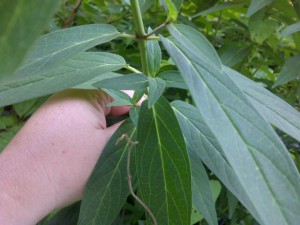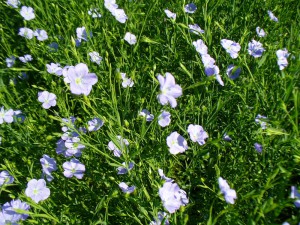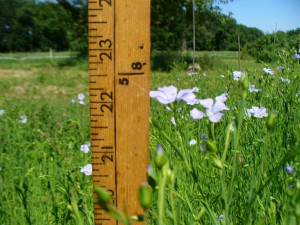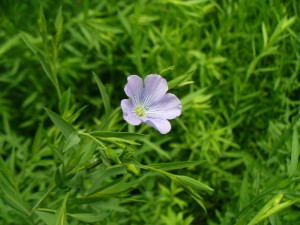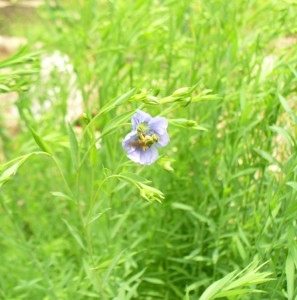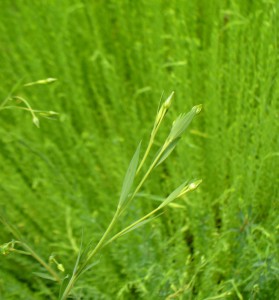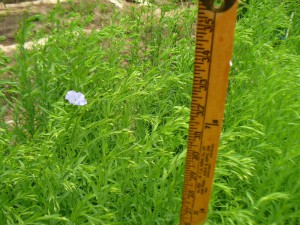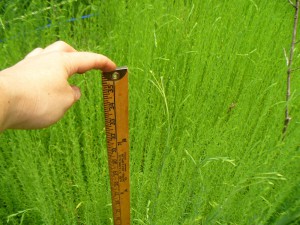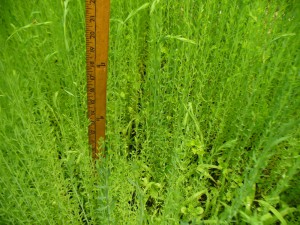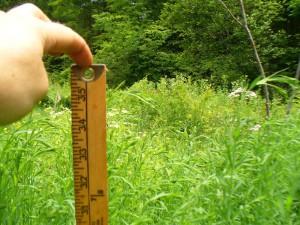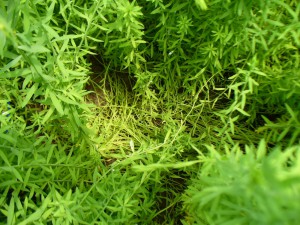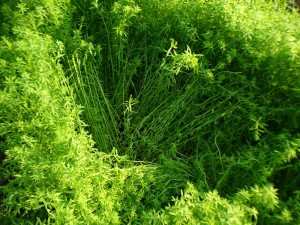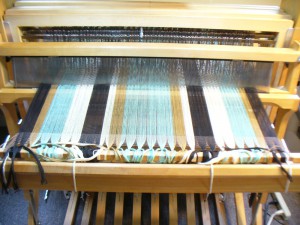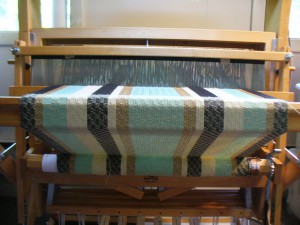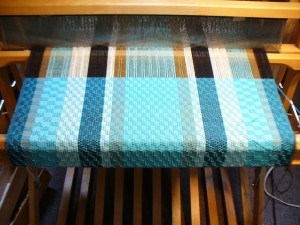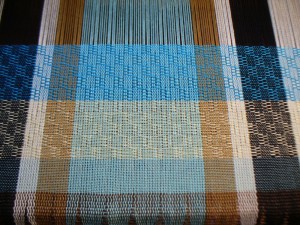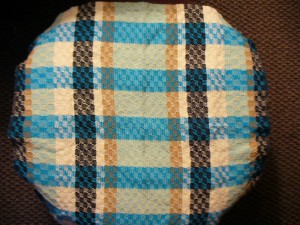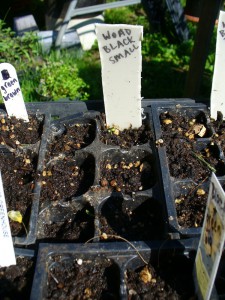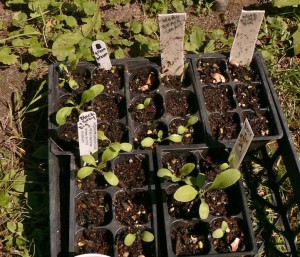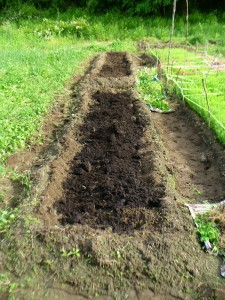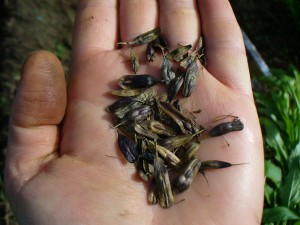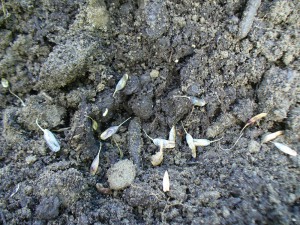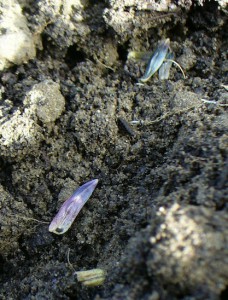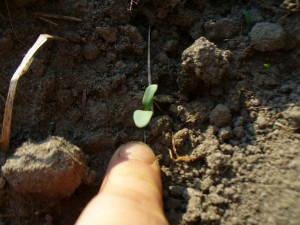Simone and I concur that our mystery cordage plant is Swamp Milkweed, Asclepias incarnata. What a name! The milkweeds are named after the Greek god of healing and medicine, Asclepius. According to The National Audubon Society Field Guide to North American Wildflowers (Eastern Region) this is “undoubtedly because some species have long been used to treat a variety of ailments.” The Latin species name incarnata means “flesh-colored,” according to the Audubon Guide. Incarnata doesn’t make it into the “epithets” list in The Hutchinson Dictionary of Plant Names: Common and Botanical, unfortunately. To me the name implies that this is the god Asclepius incarnate (made physical, made flesh, the body of the god), which is spectacular. Continue reading “Mystery Cordage Plant Identified”
Flattened Flax
I have been hesitating to post this because I don’t have much in the way of photo documentation, plus it’s sad. On Monday (June 25th) we had very heavy rain and thunderstorms. It had been very hot for a few days and I’d been watering the flax and garden each day, so I was glad for the rain. But on Tuesday I arrived at the community garden to a very sad sight. The v.n.s. looked as if someone had parted it with a comb down the middle of the bed, and then combed it flat on either side of the part. Flat. Poor flat flax. I hadn’t brought my camera, so there is no photo of the scene, but maybe you can conjure a mental image. I tried to fluff it up and shake off the excess water and encourage the stalks to stand upright again. They stood up a little, in a wobbly way, but I fear their former graceful and erect stature is gone forever. The Marilyn, which has already suffered from lodging, was also hard-hit. In contrast, the Evelin was not affected, happily.
Later on Tuesday I checked on the plot at Amethyst Farm, and there was a similar scene there.
Mystery Cordage Photos
Back in May I was visiting family in Maryland, and made some cordage from an unidentified plant growing behind my sister’s apartment. Click here to read the earlier post and Simone’s comment. Now it is in bloom, and she has sent me some photos. At first glance I think it is some kind of milkweed relative, judging by the flowers. I will look into it. Here are the leaves.
Flax Blossom Image Gallery
Happy Solstice to all! Here in Amherst it is a sweltering, bright, gloriously sunny day. Flax is in full bloom. Even though hot weather is not necessarily to flax’s liking, it has been looking stately and graceful over the past several days. I’ve been giving it extra water for encouragement.
I find flax in bloom to be unspeakably beautiful–the sweet little five-petaled structure and luminous blue color of the flowers themselves, and the way the flowers and the bright green foliage of the plants vibrate and glow together. I have taken ridiculous numbers of photographs trying to capture the exhilarating feeling of the plants and blossoms. Here are some close-ups:
Photographing Bees
I have been impressed with how many bees I see at every plot, even though only Amethyst Farm actually has honey bee hives on the property. I enjoy their little buzzing sounds, which are as soothing and blissful as a cat’s purr. I love watching them bumble up and down, and the way a flower head droops down when the bee lands. Happy bees feasting in flowers is quintessential summertime.
However, attempting to photograph bees visiting the flax flowers is like photographing fairies. I have always had a fondness for mysterious creatures such as Big Foot and the Loch Ness Monster, and have always felt sympathetic about the difficulties of photographing such elusive beings. However, getting photographic proof that the bees are actually there in the flax is proving to be as challenging as getting a clear shot of Nessie. I take photos of where the bee *was* but of course in the time that it takes to actually take the photo, the bee has moved on. And then there’s the fact that the camera will focus on other things besides the bee…. Here are some attempts:
Hmm, no bee at all. Continue reading “Photographing Bees”
More Flax Blossoms
Well, two months after planting, all the flax is blooming. This is exactly as it should be, and is very reassuring in a year when plants are otherwise not synched up with my sense of when they should be blooming (Queen Anne’s Lace already in bloom? What? Chicory??? No!!!). But, more on this later….
Back to flax news! At Amethyst Brook and Small Ones Farm, the v.n.s. wins the prize for most prolific flowers compared to Evelin and Marylin, at least at this point, at least at the times of day that I’ve observed the plants. At Amethyst Farm, I do not not observe a big difference in the number of flowers blooming between the v.n.s and Evelin, but there is a difference in height, as you will see in a moment.
Here are the plants at Small Ones Farm, as of yesterday morning, June 15th (exactly two months since planting). First, the tallest v.n.s. plants, at just over 22 inches high:
Flax is Starting to Flower
The flax in starting to bloom! These photos were all taken yesterday, June 12th, at our community garden plot at Amethyst Brook. The first variety to flower was the non-specified variety from Richters. It’s a tad shorter than the other two varieties overall, and as you may recall, it came in a little thin. This has meant that the individual stalks have more room to spread out, and the leaves seem larger on the v.n.s. than on the other two varieties. Spreading isn’t considered desirable with fiber flax, because the more branches the plant develops, the shorter the fibers will be.
Here’s one of the first beautiful flowers on the v.n.s.:
In this photo I happened to catch a little green bee-like pollinator at work. Sorry it’s blurry, but I didn’t even realize it was there until after I took the photo.
Last year I learned from Cliff Hatch at Upinngil Farm that flax flowers are pollinated by bees and other insects, and will not produce a lot of viable seed without them. I am not trying to save seed this year (hence I am growing more than one variety close together). There aren’t any beehives near the Amethyst Brook gardens, but as you can see, we get a few other pollinators.
The Evelin was full of buds yesterday, but no flowers yet:
There was one flower just barely unfurling in the Marylin bed (or Marilyn, who knows–I’ve seen it written both ways):
Measuring the heights of the plants proved a bit trickier to do by myself than I thought it would be. Again, apologies for the quality of the photos. Next time I will bring along an assistant.
The v.n.s. is about 33 inches high:
The Evelin is about 35 inches high, though there is a patch where all the plants are much shorter (one to two feet) and more spindly:
The Marylin is a full 36 inches and some plants are taller.
However, it has suffered from lodging, which is when the plants fall over and don’t straighten up again.
noticed the lodging at the end of May. Here’s how it looked on May 28th.
I decided not to do anything to correct the problem (for example, staking). The point of the whole exercise this year is to see how different varieties compare under similar conditions. The Marylin came in very thickly compared to the other two varieties, and grew much faster initially. I think this may be have due, in part, to the competition between the plants. In theory, you want to sow thickly so the plants will grow as tall as possible and as straight as possible, without branching. However, perhaps they outpaced themselves, and got too tall for their own stalks to support. Maybe Marylin needs to be planted less densely.
Anyway, that’s the news from flax land.
Dishtowels for Pioneer Valley Weavers’ Guild
I am a member of two local weaving guilds, Pioneer Valley Weavers’ Guild and Weavers of Western Massachusetts. The Pioneer Valley Weavers did a community service project this year where members wove dishtowels to donate to the Big Brothers Big Sisters fundraising auctions this summer and fall.
I decided to use Ms and Os for my weave structure, to get some nice bumpy texture. Here are my dishtowels in process. Here is the warp threaded, sleyed, tied on, and ready to go:
It is a mixture of different sizes of cotton yarns, as I was trying to use old yarns from my stash. So, the black is 6/2, the light green and gold are 10/2, and the cream is 8/2. I think they are all mercerized, but they are still soft enough to be absorbent. The width is 22.3 inches in the reed, and it’s 536 ends sett at 24 epi, sleyed 2 per dent in a 12 dent reed. I wound a 4 yard warp, which I thought would be enough for three full sized towels. As it turned out, I only had enough for two towels and one smaller napkin or bread-basket sized cloth.
One towel has a pale yellow 22/2 cottolin weft:
I like this one because the values and proportions in the stripes work the way I imagined, and I like the lacy feeling.
I wove the other towel with a bright turquoise blue 6/2 cotton weft:
The intensity/saturation of the turquoise interferes with the stripes. As Matthew put it, everything feels like it’s underwater. In future, to use this color weft again, I would redesign the stripes in a smaller scale and with different colors. I think that a more intense bright yellow would work better than the gold, for example. On the other hand, several people to whom I showed the finished towels said they preferred the turquoise one.
For the smaller napkin-sized piece, I alternated the turquoise and pale yellow, and I like the plaid effect a lot (the pale green stripe at the bottom is plain weave, which I sewed into the hem).
Above, the napkin-sized cloth looks round because it’s draped over a round foot stool, but I think you can see the plaid effect pretty well.
Woad Seed Germination Experiments
In my last post I referred to the germination experiments I did last summer and I went back through old posts so that I could link to the one about woad seeds. However, it turns out that I never wrote about the woad seeds. I spent a long time writing about weld seeds, in the category of “what I did this summer,” then moved on to writing about fall projects.
Here is the belated summary of my woad seed experiments from summer 2011.
I sorted the seeds by color and size. Categories included “black big,” “black small,” “green brown,” “black and gray big,” and “black and green big.” I planted them into little cells with labels.
Here’s a photo of the set up.
And, in short, they all grew. Oddly, the “black big” took longer to grow.
My conclusion from this experiment was that I didn’t need to sort woad seeds and save only the biggest or darkest in color. Also, you need to plant at least twice as many seeds as the number of plants you want, since in each color-and-size category the germination rate was low. I don’t know whether the appearance of the seed has any relationship to the amount of color a plant produces. I doubt it, but it would be hard to prove.
Planting Woad At Last
I have been meaning to plant woad since April, and have had the beds dug for weeks. Not sure what the hold-up has been, but I finally planted one bed last Wednesday morning May 23rd before my shift at Shelburne Arts Co-op.
The soil at our garden is sandy and not rich in organic matter, and woad is a heavy feeder. In the past couple years I have been happy and impressed with my woad plants at Bramble Hill Farm at my little fiber and dye plant garden, and unhappy with my plants at our community garden. In an attempt to get burlier plants at the community garden, I put 6 bags of compost and cow manure into the two beds I dug, and plan to side dress with organic fertilizer during the season.
Here is a shot of the nice dark manure/compost combo:
By the way, I bought the bagged compost and cow manure from Annie’s (12/19/23 Edited to add that Annie’s is sadly no longer in business. I removed the link.). As I was waiting to pay for it, I was in line behind a woman who spent about $100 on lovely gifts that she was getting wrapped up. The process was taking a little while, and I was standing there waiting with nothing in my hands. So the cashier politely asked me if I was being helped. I said it was OK, I was just waiting to pay for manure. Both of the women looked at me for a moment, and the cashier said, “Manure?” I realized the extreme contrast between my purchase and that of the customer in front of me, and replied, “Well, you have it all here.” That is, Annie’s has beautiful things as well as practical ones. And they do.
Which reminds me of another anecdote. The paternal side of my family traditionally plays a card game called Beacon Hill Rummy when we have family get-togethers at our cabin on Queen Lake. It is customary to comment on one’s hand and luck during the game (it’s not poker, in fact it is like the anti-poker) and once a family member described his or her hand as a “sack o’ poo,” meaning it was terrible. Matthew and I commented that we regularly pay good money for sacks of poo for our garden, and in fact it’s probably our biggest expense in gardening. In manure as in cards, one person’s trash is another person’s treasure. This past holiday season, imagine my delight when I saw these (12/19/23 Edited to add that the bags of guano and other fancy poop are no longer for sale. I removed the link) listed in the Pinetree Seeds catalogue. Not a sack of coal, but a sack o’ poo for every boy and girl. Exotic poo.
OK, back to the woad. I plan to plant two large beds. The beds are almost as long as the flax beds (14 feet) but I left a path in between for weeding and watering. So they’re about 13 feet long and 3 feet wide.
Here is a handful of woad seeds.They vary in color from green to purple, but all except the lightest, thinnest yellow ones will grow (I know this from some germination experiments I did last summer).
I have a lifetime supply so I plant wantonly.
Here’s a close-up. I think woad seeds are beautiful. Actually, I think woad might be my favorite dye plant.
As of Monday May 28th the woad is up! Here are some photos of the cute little seedlings.


